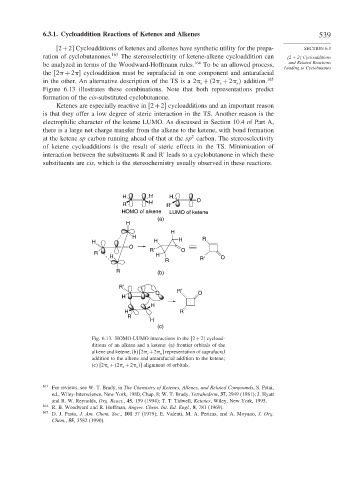Page 565 - Advanced Organic Chemistry Part B - Reactions & Synthesis
P. 565
6.3.1. Cycloaddition Reactions of Ketenes and Alkenes 539
2+2 Cycloadditions of ketenes and alkenes have synthetic utility for the prepa- SECTION 6.3
ration of cyclobutanones. 163 The stereoselectivity of ketene-alkene cycloaddition can [2 + 2] Cycloadditions
be analyzed in terms of the Woodward-Hoffmann rules. 164 To be an allowed process, and Related Reactions
Leading to Cyclobutanes
the 2 + 2 cycloaddition must be suprafacial in one component and antarafacial
in the other. An alternative description of the TS is a 2 + 2 + 2 addition. 165
s
s
s
Figure 6.13 illustrates these combinations. Note that both representations predict
formation of the cis-substituted cyclobutanone.
Ketenes are especially reactive in 2+2 cycloadditions and an important reason
is that they offer a low degree of steric interaction in the TS. Another reason is the
electrophilic character of the ketene LUMO. As discussed in Section 10.4 of Part A,
there is a large net charge transfer from the alkene to the ketene, with bond formation
2
at the ketene sp carbon running ahead of that at the sp carbon. The stereoselectivity
of ketene cycloadditions is the result of steric effects in the TS. Minimization of
interaction between the substituents R and R leads to a cyclobutanone in which these
substituents are cis, which is the stereochemistry usually observed in these reactions.
H H H O
R H R′
HOMO of alkene LUMO of ketene
(a)
H
H
H R
H H H
O R′
R O
H H R′ O
R
R (b)
R′
O R′ O
H
H
H R
R
H
(c)
Fig. 6.13. HOMO-LUMO interactions in the 2+2 cycload-
ditions of an alkene and a ketene: (a) frontier orbitals of the
alkene and ketene; (b) 2 s +2 a representation of suprafacial
addition to the alkene and antarafacial addition to the ketene;
(c) 2 s + 2 s +2 s alignment of orbitals.
163 For reviews, see W. T. Brady, in The Chemistry of Ketenes, Allenes, and Related Compounds, S. Patai,
ed., Wiley-Interscience, New York, 1980, Chap. 8; W. T. Brady, Tetrahedron, 37, 2949 (1981); J. Hyatt
and R. W. Reynolds, Org. React., 45, 159 (1994); T. T. Tidwell, Ketenes, Wiley, New York, 1995.
164 R. B. Woodward and R. Hoffman, Angew. Chem. Int. Ed. Engl., 8, 781 (1969).
165
D. J. Pasto, J. Am. Chem. Soc., 101 37 (1979); E. Valenti, M. A. Pericas, and A. Moyano, J. Org.
Chem., 55, 3582 (1990).

